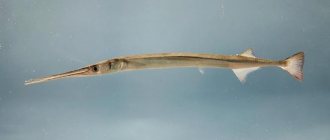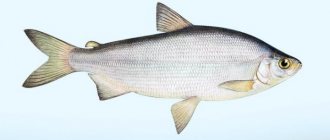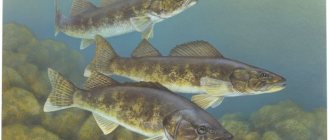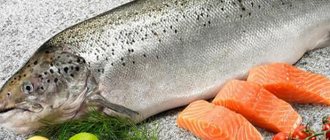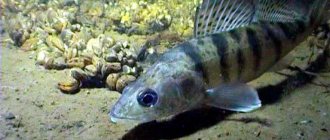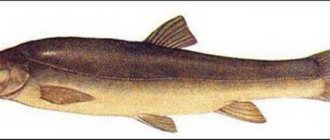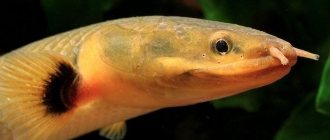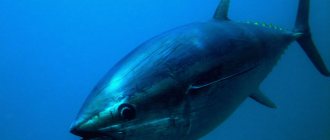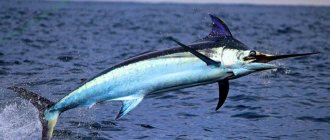Bluefish: description
The Black Sea bluefish is a fish that can be recognized among millions of others by its elongated and slightly flattened body, covered with small round-shaped scales, with sharp spiny fins on the back. The tail of the fish is fork-shaped, the pairs of fins on the abdomen are small and short.
The color of the bluefish fish is dark on the back, light silver on the sides and whitish throughout the belly. This sea creature has a large head with a huge mouth, the lower jaw of which is pushed slightly forward.
Just from one type of bluefish you can understand that this is a predatory fish, and if you also take into account that its size can reach up to 140 cm in length and weight up to 15 kg, then you can begin to fear these representatives of the aquatic fauna. But you shouldn’t be afraid, bluefish is a fish with a beautiful name, which is completely safe and cannot cause any harm to swimmers or fishermen.
bluefish
Home ❱
Flora and fauna
❱
Fishes of the Black Sea
❱
bluefish
One of the species of Black Sea fish, found in abundance in the Krasnodar region. Anglers know bluefish well, both by sight and taste. Externally, it is a medium-sized fish with a powerful, flattened body on the sides. The mouth is toothy, large, the teeth are widely spaced and in the same row. Two fins on the back. In the place in front of the lower fin, located next to the anus, three small spines can be distinguished.
Bluefish are also distinguished by a dark spot, sometimes with a yellow border, on the chest, where the pectoral fins begin. From the back they are greenish-blue, on the sides the color is lighter, and the belly is completely white. Bluefish live in large schools, are found in open areas of the sea, and swim to the shores only with the onset of spring and summer. This is in both seas of the region. In autumn, when the average temperature drops to 13 degrees Celsius, schools of fish migrate to the Sea of Marmara, where they overwinter and breed. In May they come back to feed. Bluefish are found everywhere in subtropical seas with oceans in the Northern and Southern hemispheres. The length of a large bluefish is up to 1.25 m, and its weight is up to 22 kg or more. In Evpatoria and the Kerch Bay you can find smaller fish - on average up to 56 cm and weighing up to 2 kg. From 2 years old, the fish is considered capable of reproduction, and each female can lay up to a million eggs per season. The breeding season mainly occurs during summer days.
Predators
The bluefish menu most often consists of pelagic or bottom small animals - these are mackerel or mullet, herring, crabs, and they do not disdain worms. The fish is considered a true pelagic predator and in search of food, bluefish quickly cuts through the water and can sometimes jump above the surface in pursuit. Sometimes, having eaten, he regurgitates what he has eaten and again swims to fish. Until they grow up, juveniles most often catch small crayfish, and when they reach 11 cm in length they switch to the menu of predatory fish.
Fishing
Back in the late 60s in the last century, Ukrainian fishermen caught hundreds of tons of bluefish every year. The population began to fall and at this time it has almost ceased to be caught, although in Turkey, on the shores of the same Black Sea, fishermen do not disdain bluefish. The fish also fall into the set nets, although most often more are caught in places of accumulation with cast nets or hooks. Bluefish meat is delicious and is loved for its delicate taste. You can eat fresh, dry or salt the fish. Fans of spinning fishing hunt for bluefish for sport. They know that fish bite best in the early morning hours or in the evening, when the fish itself is hunting for another. Fishermen also know that when hooked, it is difficult to pull a bluefish out of the water - it will resist to the last, including abruptly going down into the depths, and the catching process can last for hours.
You might be interested
- Marine Spikefish
Marine Spikefish
- Sea ruff
Sea ruff
- Sea bass
Sea bass
- Black Sea mackerel
Black Sea mackerel
Noticed an error or irrelevant information? Please inform
us about this
send a message
Send Cancel
Where are the bluefish found?
Bluefish are found at depths of 150-200 meters and usually live in schools. In summer, it often moves to river mouths and coastal areas, but with the onset of cold weather it returns to the sea, to its familiar environment.
Fishermen often call bluefish “Black Sea”, believing that they live in the Black Sea, however, these individuals can be seen not only in the indicated place. More than once the fish was spotted in the Kerch Strait, the Sea of Azov, the Indian and Pacific Oceans, and even off the coast of Africa.
Depending on the time of year (season), atmospheric pressure in the water and air temperature, bluefish fish can either swim at great depths or rise almost to the surface of the reservoir.
Bluefish fishing: what kind of fish is it and what gear to use when catching it
Bluefish fish will not leave any fisherman indifferent.
Thanks to its biological characteristics, catching underwater inhabitants turns into a real adventure. Knowing the nature and preferences of the bloodthirsty predator, catching bluefish will not be difficult even for novice fishermen. Bluefish fish belongs to the species of ray-finned fish, to the order Perciformes. The fish can reach very large sizes - up to 140 cm in length, weighing about 15 kg. Not everyone will be able to catch such a fish. After all, most often individuals of standard sizes 40 - 50 cm with a body weight of up to 3 kg are caught on the hook. The body of the bluefish is slightly compressed from the sides, covered with round scales. There are two dorsal fins, which are separated by a small gap. The mouth is studded with a large number of sharp teeth, the jaw is large.
The predator usually lives in the Black Sea and is often found in the Sea of Azov and the Kerch Strait. When migrating, fish cover long distances and enter river mouths. The predator is a schooling fish, and they move in huge schools of more than 200 fish. Fish usually live near the surface of the water. Bluefish swim very quickly and develop great speed, especially when it comes to chasing fry.
Active predators purposefully attack their prey, performing various tricks and even jumping out of the water. Carried away by the process, the predator often finds itself on a sloping bank. Before pouncing on the prey, the bluefish, with its head held high, inflates its gills and sharply grabs the prey. After which he instantly swallows the food and returns to the flock.
Bluefish feeding
Since fish are predators, they usually feed on smaller fish. Local fishermen call the fish “Black Sea wolf”, this is due to some features of their behavior. In some cases, a representative of ray-finned fish grabs the victim and tears out several pieces of meat from it, after which it switches to another fish.
Because of this behavior, many believe that the goal of the bluefish is not to eat food, but to destroy the young. The fish is very voracious and bloodthirsty. Their prey can be any fish that they meet along the way. Usually the victims are horse mackerel, herring and even mackerel. However, this factor of aggression is absolutely safe for humans. When a human silhouette appears in the water, a flock of predators quickly takes off on the run.
To get a big catch of bluefish, you need to understand their behavior in different seasons and weather conditions. Let's take a closer look.
Alushta is one of the most fishing regions of the Crimean Peninsula. There is even a village nearby called Rybachye, which is also the best place for fishing in Crimea. In Alushta, a holiday here in any case means going out to sea for sea fishing, or at least catching fish from the shore. Also not far from Alushta there is a small lake where you can go for a picnic and go fishing for freshwater fish.
Bluefish are rarely larger than 40 - 50 cm
Today we’ll talk about fishing for bluefish, which lives in the Black Sea and is found in the Kerch Strait and the adjacent southern territory of the Azov Sea. This fish tries to stay in schools close to the shore, where there are constant local currents and where there is a concentration of small fish.
Relatively small in size (average weight 2-2.5 kg, with a length of 40-50 cm), the bluefish is a fairly insatiable predator, eating mainly small fish. Bluefish persistently pursue schools of small fish like horse mackerel, silverside fish, and anchovy. The main fishing season for bluefish with a spinning rod begins when small fish swim closer to the shore - in mid-summer and almost until the end of autumn.
It also happens: Catching medicinal leeches - Development
To fish for bluefish, you need a two-handed spinning rod with an inertial reel. The fishing line should have a diameter of 0.4 - 0.5 mm. From inertia-free coils, “Dolphin” or “Dolphin-8” coils may be suitable. You need to choose oscillating, elongated spoons, for example: “sports” or “wonderful”, in which the concave parts (at the leash) are filled with molten tin, having previously tinned them.
Fishermen from Alushta successfully catch bluefish using homemade stainless steel spoons, the length of which is 10-12 cm, thickness approximately 5 mm, and width 1-1.2 cm at the head (at the leash), and 0.5-0.6 cm at tail, tee, use No. 10 - 12. Bluefish rarely come close to the shores, only immediately after the end of the storm, so they fish for them mainly from a boat. In the vast expanses of the sea, it is problematic to find bluefish; it is also useless to cast a spinning rod at random - this will only alert the fish.
The surest way to spot bluefish concentrations is to watch the sea surface. Bluefish, like freshwater perches, hunt in a school: as if on command, crashing into the middle of a school of small fish, bluefish push some of the fish to the surface, actively pursuing victims, greedily eating the poor creatures. The attack of bluefish is accompanied by quite noisy splashes. Mandatory participants in bluefish attacks are seagulls: from the behavior of these birds, from afar you can guess the place of the bluefish feast.
What better way to spend your time than this?
Seeing such a sight, immediately swim up to this place, cast the bait into the middle of the stormy sea with a long cast and, without letting it sink too deep, reel in the line at a pace of approximately 1.5-2 revolutions per second. The bluefish bite sharply, like a freshwater asp. A hooked bluefish immediately goes into the depths, then rises to the surface, emerges from the water and rushes to the side.
Often during these manipulations, the bluefish breaks off the hook, so after the first jerk, you need to immediately hook so that the fish does not fall off. We put the reel drum on the brake and fish out. Be prepared for active resistance, the bluefish desperately resists, much more energetically than its freshwater counterparts of the same size.
Waste paper is various types of paper and cardboard products that have served their useful life. Simply put, this is paper waste.
Recycling waste paper is not only a fairly profitable business, but also protects the environment. Companies that accept waste paper pay very good money for it, the price per ton of waste paper is simply amazing, so handing over waste paper is beneficial for any resident of Russia who has a large amount of unnecessary paper or cardboard products accumulated at home.
The use of waste paper as a raw material for production can significantly reduce deforestation. It should be added that you can recycle waste paper 5-7 times, until then its fibers become completely unsuitable for paper production.
Lifestyle
Bluefish spend most of their life underwater in schools. The number of fish in one such school can reach several thousand, but more often it ranges from 900 to one and a half thousand.
When hunting for prey, bluefish show unshakable passion. Seeing schools of smaller fish, these predators break up into small schools and quickly rush for prey. Having overtaken their prey, they jump after it, grab it in a jump and immediately eat it. After lunch, so to speak, the bluefish again gather into one large school and continue their movement under water.
Reproduction and spawning
Bluefish reach sexual maturity at four to five years of age, but some individuals are ready for spawning from the age of two years, while others, on the contrary, spawn in the eighth or ninth year. Fish spawn in warm, well-warmed water by the sun from the beginning of June to the end of August.
The female lays eggs in portions, which swim further into the open sea. Other underwater inhabitants often feed on caviar, and therefore their high fertility saves the population of bluefish in the sea. At one time, females lay several hundred eggs, and some of the largest individuals lay even more - up to a million eggs. After two days, these eggs, if they manage to survive, hatch into floating tiny larvae, they are carried over vast distances with the help of fast currents, and then turn into full-fledged fish that grow quickly, although they do not mature too quickly for reproduction. Let us remind you once again that bluefish can begin to spawn only by the age of five.
Useful properties and contraindications
The benefits of bluefish for humans are enormous. The meat of these fish is tasty, low-fat, low-calorie and endowed with a number of healing microelements, vitamins and minerals. Being a constant part of the human diet, fish can influence:
- - on the composition of the blood, improves and renews it;
- - on metabolic processes, improves metabolism;
- - on bones and muscles, increases the strength of bone and muscle tissue;
- - on immunity, increases the protective functions of the body, its resistance to diseases;
- - on water balance, normalizes it;
- - on the cardiovascular system, restores blood pressure, improves heart function;
- - on the skin, nails, hair, nourishes them, makes them more beautiful and healthy.
Due to the content of iron and other nutrients, fish meat can, with its constant consumption, relieve anemia, improve blood flow and enrich the body with useful elements.
Contraindications:
- — individual intolerance to fish products;
- - liver problems;
- - for obesity;
- - diseases of the pancreas and stomach.
How to cook bluefish
Black Sea bluefish is a fish that is very loved by chefs all over the world. You can prepare a huge number of dishes from it, including lean, low-calorie dishes. World experts prepare bluefish fillet in batter, in a creamy sauce, on the grill, boil and stew the fish, bake it with cheese or with tomatoes, and add it to exotic salads.
Ordinary people at home bake bluefish in the oven, make fish soup (fish soups) from them, or fry them in a frying pan. Some of the meat of these fish is used to prepare minced cutlets, for filling dumplings or savory pastries and pies. Dense and tasty bluefish meat is excellent when salted, dried or canned.
In Russia, bluefish is sold frozen and the cost of such a seafood delicacy is not too high.
How to catch bluefish?
Bluefish is an amazing fish, sometimes called the Black Sea piranha. This is a pronounced predator, voracious and insatiable. Usually it accumulates in schools and stays in coastal waters, where there are constant currents and where there is a lot of small fish.
It also happens: Lures for tuna fishing - About fishing
On average, the weight of a bluefish that catches a fisherman’s hook can vary from 2 to 4 kg, and its length is 40-60 cm. This voracious predator is always persistent in pursuing smaller fish, and schools of anchovy, mackerel, silverside and other small fish become its prey fish. The bluefish fishing season begins when schools of various small fish approach the shore.
To catch this fish you will need a two-handed spinning rod equipped with an inertial reel “Kyiv”, “Nevskaya” “KS300”, you can also use an inertia-free reel of the “Dolphin” type. The fishing line used for the equipment should have a cross-section of 0.4-0.5 mm. Of the baits, it is most practical to use spinners with an elongated shape such as “wonderful” or “sports”, the concave part of which is usually filled with tin. A bait weighted in this way is more attractive for bluefish due to its performance. It also becomes unnecessary to attach an additional sinker.
Sea fishing for bluefish using homemade stainless steel spoons 12-15 mm wide, about 5 mm thick and 100-120 mm long is also very effective. The bait is equipped with a tee No. 10-12.
Bluefish rarely come close to the shore. This usually happens only after a storm, and because of this, bluefish fishing is usually done from a boat. In the wide expanses of the sea it is quite difficult to spot this fish. It is also completely fruitless to fish the sea with a spinning rod at random, since a lonely shining bait can only alert the bluefish.
The surest way to find bluefish is by observing the water surface. Just like the perch of freshwater reservoirs, this fish hunts in schools and, as if on command, rushes into the very center of a school of small fish. The bluefish pushes part of the small fish to the surface and greedily devours it there. The noisy splashes of the bluefish immediately reveal the location of the “fight.” Where such a fight takes place, seagulls always appear and this is another sign by which bluefish can be identified.
If you manage to find such a place, then bluefish fishing will definitely be successful. With a long cast, send the bait straight into the middle of such a cauldron, but do not let it dive too deep. Wind the line at intervals of 1-2 turns per second. The grip of this predator is as sure and sharp as that of the famous asp.
In this regard, after the first sharp bite of a bluefish, you should immediately hook it so that the hook is firmly stuck into the bony mouth of the predator, then put the reel on the brake and start fishing. Fishing this fish is a real pleasure.
One of the best places on the Black Sea coast for bluefish fishing is Alushta. This is perhaps the most fishy region of the Crimean Peninsula. It is off the coast of Alushta that fishing for bluefish is the most catchy.
A little about the habits and character of the bluefish. As mentioned earlier, this is a schooling predatory fish that collectively hunts for anchovy, horse mackerel, sardines and other small fish. The bluefish attacks fiercely and harshly. He even tears his prey into pieces, even when he is completely satiated. In this case, he eats a small share of his prey, and the rest goes to smaller marine inhabitants.
Bluefish breed in the water column, since this predator comes close to the shore only in the summer. Basically, bluefish become prey for fishermen only when hunting for schools of small fish, when a “bluffar fight” occurs. But sometimes the bluefish comes close enough to the shore and then the fishermen cast their gear directly from the piers and moorings, to the maximum possible distance. It is at such moments that bluefish fishing from the shore is very promising.
But such situations arise quite rarely, and it is mainly caught using watercraft at a depth of about 100 m, and even more.
It also happens: What do fishermen do when they can’t catch tuna? Tuna fishing with spinning rod
Bluefish can be used to prepare excellent dishes. Bluefish has very tasty meat. It can be fried, cooked under a weak marinade, stewed with vegetables and spices, smoked, or made into canned food.
Bluefish fishing is very popular in all countries located on the Mediterranean and Black Sea. The best places in Russia where bluefish are caught are the coast of Crimea, the Kerch Strait and the coast of Sochi.

